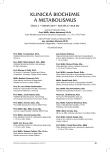Rare pyrophosphate renal stone in 5 years old boy with congenital hypophosphatasia
Authors:
M. Polák 1; K. Kotaška 1
; L. Plachý 2; R. Průša 1; M. Fořtová 1
Authors‘ workplace:
Ústav lékařské chemie a klinické biochemie 2. LF UK a FN Motol, Praha
1; Pediatrická klinika 2. LF UK a FN Motol, Praha
2
Published in:
Klin. Biochem. Metab., 27, 2019, No. 2, p. 90-95
Overview
Objectives: Identification of unusual renal pyrophosphate stone in 5 years old patient with congenital hypophosphatasia.
Design: Case report and evaluation of laboratory results.
Settings: Department of Medical Chemistry and Clinical Biochemistry, University Hospital Motol, Charles University, Second Faculty of Medicine, Department of Paediatrics, University Hospital Motol, Charles University, Second Faculty of Medicine, V Úvalu 84, 150 06 Prague 5 (Czech Republic).
Material and methods: Case report focusing on determination of urinary stone composition by polarized light microscopy and infra-red spectrometry.
Results: In 5 years old patient with effectively treated congenital hypophosphatasia by recombinant alkaline phosphatase (the serum value of which was ten times the upper limit of the reference range), rare pyrophosphate renal stone with addition of sulphate was demonstrated. The formation of the stone occurred in the period when the patient´s urine was thera-peutically alkalized (due to the history of urate stones) and the patient used prophylactically sulfonamides prior to planned lithotripsy.
Conclusion: Despite the high serum alkaline phosphatase concentration, the function of which is the conversion of pyrophosphate to phosphate, pyrophosphate renal stone was identified in a patient with congenital hypophosphatasia. The sulphate component of the stone is probably due to the prophylactic administration of sulfonamides.
Keywords:
renal stone – pyrophosphate – sulphonamides – congenital hypophosphatasia – infra-red spectrometry
Sources
1. Jobs, K., Rakowska, M., Paturej, A. Urolithiasis in the pediatric population - current opinion on epidemiology, patophysiology, diagnostic evaluation and treatment. Dev Period Med., 2018, 22 (2), p. 201–208.
2. Sobotka, R., Hanuš, T. Příčiny a rizikové faktory vzniku urolitiázy. Urol. praxi, 2012, 13 (1), p. 11–15.
3. Moochhala, S. H., Sayer, J. A., Carr, G., Simmons, N. L. Renal calcium stones: insights from the control of bone mineralization Exp. Physiol., 2007, 93 (1), p. 43–49.
4. Šumník, Z., Souček, O., Lebl, J. Hypofosfatázie: Kdy na ni myslet a jak ji léčit. Pediatr. praxi, 2016, 17 (3), p. 146–149.
5. The Tissue Nonspecific Alkaline Phosphatase, Gene Mutations Database, SESEP Laboratory (Versailles Hospital - Unit of Constitutional Genetics) and the Unit of Cell and Genetics, University of Versailles-Saint Quentin en Yvelines, France [online]. 2019-02-10 [cit. 2019-01-15]. Accessible on WWW: <https://www.sesep.uvsq.fr/03_hypo_mutations.php>
6. Mornet, E. Hypophosphatasia. Orphanet J. Rare Dis., 2007, 2 (1), p.1–8.
7. Whyte, M. P. Hypophosphatasia and the role of alkaline phosphatase in skeletal mineralization. Endocr Rev., 1994, 15 (4), p. 439–461.
8. Orimo, H. The mechanism of mineralization and the role of alkaline phosphatase in health and disease. J. Nippon Med. Sch., 2010, 77 (1), p. 4 – 12.
9. Kodíček Milan Biochemické pojmy – výkladový slovník. Difosfát. Verze 1.0 Praha [cit. 2019-01-15]. Dostupný na WWW:<https://vydavatelstvi-old.vscht.cz/knihy/uid_es-002_v1/hesla/difosfat.html>. ISBN 80-7080-551-X.
10. Rachow, J. W., Ryan, L. M. Inorganic pyrophosphate metabolism in arthritis. Rheum. Dis. Clin. North. Am., 1988, 14 (2), p. 289–302.
11. Russell, R. G. Metabolism of inorganic pyrophosphate (PPi). Arthritis Rheum., 1976, 19 (Suppl. 3), p. 465–478.
12. Jung, A., Russel, R. G., Bisaz, S., Morgan, D. B., Fleisch, H. Fate of intravenously injected pyrophosphate-32 P in dogs. Am. J. Physiol., 1970, 218 (6), p. 1757–1764.
13. Nouwen, E. J., De Broe, M. E. Human intestinal versus tissue-nonspecific alkaline phosphatase as complementary urinary markers for the proximal tubule. Kidney Int., 1994, 47, p. 43 – 51.
14. Hypophosphatasia Signs and Symptoms. [online]. 2014-09-10 [cit. 2019-01-15]. Dostupný na WWW: <https//hypophosphatasia.com>
15. Chaloupek, K., Bartoníková, A., Souček, O., Šumník, Z., Vlk, R., Černý, M. Perinatální forma hypofosfatázie – kazuistika (abstrakt). Neonatologické listy, 2014, 20 (2), p. 39.
16. Šumník, Z., Černý, M., Bačkai, T., Padidela, R., Souček, O. Kolik stojí letenka do Manchesteru? (abstrakt). Osteol. Bull., 2015, 20 (2), p. 90.
17. Metz, M. P. Determining urinary calcium/creatinine cut-offs for the paediatric population using published data. Ann. Clin. Biochem., 2006, 43, p. 398–401.
18. Matos, V., van Melle, G., Boulat, O., Markert, M., Bachmann, C., Guignard, J. P. Urinary phosphate/creatinine, calcium/creatinine, and magnesium/creatinine ratios in a healthy pediatric population. J. Pediatr., 1997, 131 (2), p. 252–257.
19. Simplified Infrared Correlation Chart University of Wisconsin, Department of chemistry [online]. [cit. 2019-01-15]. Accessible on WWW: <https://www.chem.wisc.edu/deptfiles/OrgLab/handouts/Simplified%20IR%20Correlation%20Chart.pdf>
20. Frank, A., Norrestam, R., Sjödin, A. A new urolith in four cats and a dog: composition and crystal structure. J. Biol. Inorg. Chem., 2001, 7 (4–5), p. 437–444.
21. FDA – BactrinTM [online]. [cit. 2019-01-15]. Accessible on WWW: <https://www.accessdata.fda.gov/drugsatfda_docs/label/2013/017377s068s073lbl.pdf
22. Whyte, M. P., Greenberg, C. R., Salman, N. J. et al. Enzyme-replacement therapy in life-threatening hypophosphatasia. N. Engl. J. Med., 2012, 366 (10), p. 904–913.
23. Whyte, M. P., Rockman-Greenberg, C., Ozono, K. et al. Asfotase Alfa treatment improves survival for perinatal and infantile hypophosphatasia. J. Clin. Endocrinol. Metab., 2016, 101 (1), p. 334–342.
Labels
Clinical biochemistry Nuclear medicine Nutritive therapistArticle was published in
Clinical Biochemistry and Metabolism

2019 Issue 2
Most read in this issue
- Comparison of troponin I (Abbott, Beckman Coulter, Siemens) and troponin T (Roche) high-sensitivity measurement results
- POCT system for the fecal calprotectin detection in the tele-monitoring of patients with inflammatory bowel disease
- Changes in urinary and serum markers of renal injury in adult patients after angiographic contrast medium administration
- Fatty acid elongases and their involvement in the pathogenesis of disease states
